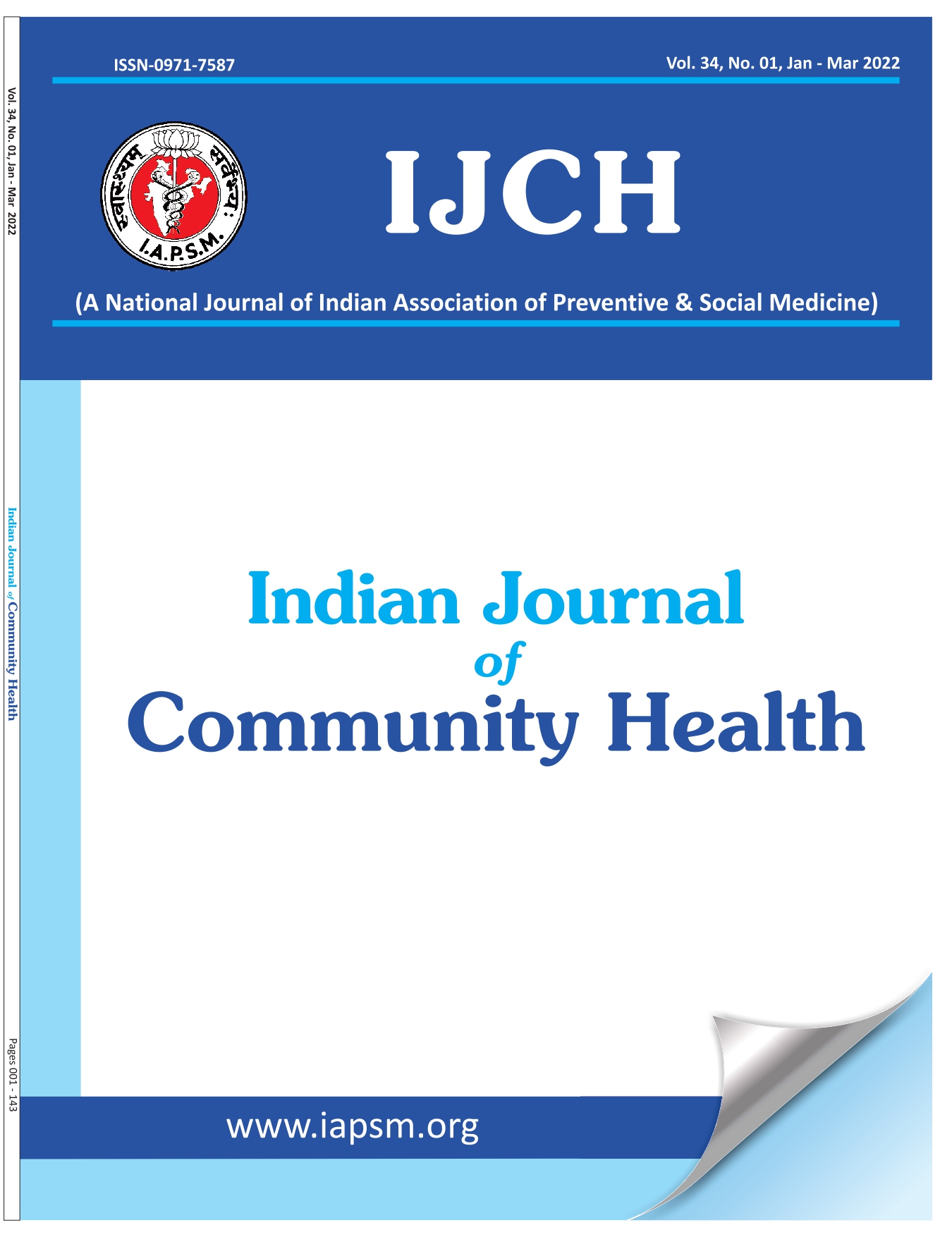Drug adherence to anti-tubercular treatment during COVID-19 lockdown in Haldwani block of Nainital district
DOI:
https://doi.org/10.47203/IJCH.2022.v34i04.016Keywords:
Tuberculosis, Adherence, Non-Adherence, COVID-19, LockdownAbstract
Background: India saw one of the stringent lockdowns during the COVID-19 pandemic. In the wake of this period, the normal functioning of medical services was affected. People were reluctant to seek medical attention and notification of Tuberculosis dipped. The aim of the study was to estimate the proportion of non-adherence to anti-tubercular treatment and to identify the factors affecting the non-adherence to treatment. Methods: A retrospective community-based study was conducted among 284 tuberculosis patients. They were interviewed using a pre-designed questionnaire consisting of WHO dimensions of non-adherence and lockdown related questions. Results: The proportion of non-adherence to treatment was found to be 5.3%. Factors like chronic diseases, depression, without knowledge on how the disease is transmitted and that medication can be discontinued once the symptoms subsided, alcohol consumption, and trouble accessing medicine were found to be the determining factors in non-adherence to the treatment. Conclusions: Non-adherence to anti-tuberculosis treatment in our study was low but the various dimensions of adherence along with lockdown related factors had significant impact on it. To further minimize non-adherence during emergency like the lockdown due to COVID-19 pandemic, corrective measures must be explored and implemented.
Downloads
References
Guidelines on the measures to be taken by Ministries/ Departments of Government of India, State/Union Territory Governments and State/ Union Territory Authorities for containment of COVID-19 Epidemic in the Country | COVID-19 Inter-Ministerial Notification [Internet]. 2020. [cited 2022 Dec 15]. Available from: https://covid19.india.gov.in/document/mha-order-covid-19/
Government of India issues Orders prescribing lockdown for containment of COVID-19 Epidemic in the country [Internet]. 2020 [cited 2022 Dec 15]. Available from: https://pib.gov.in/PressReleasePage.aspx?PRID=1607997
Global tuberculosis report 2019 [Internet]. WHO. 2019 [cited 2022 Dec 15]. p. 2. Available from: https://www.who.int/publications/i/item/9789241565714
Tuberculosis [Internet]. WHO. [cited 2022 Dec 15]. Available from: https://www.who.int/health-topics/tuberculosis#tab=tab_1
Global tuberculosis report 2020 [Internet]. WHO. [cited 2022 Dec 15]. Available from: https://www.who.int/publications/i/item/9789240013131
SEAR Covid-19 Dashboard [Internet]. WHO. [cited 2022 Dec 15]. Available from: https://who.maps.arcgis.com/apps/dashboards/73d1d3251de3435cbc0bc586230cc3ef
Bhatia V, Mandal PP, Satyanarayana S, Aditama TY, Sharma M. Mitigating the impact of the COVID-19 pandemic on progress towards ending tuberculosis in the WHO South-East Asia Region. WHO South-East Asia J Public Heal. 2020;9(2):95.
Park K. Park’s Textbook of Preventive & Social Medicine. 25th ed. M/s Banarsidas Bhanot; 2019:188-189.
Mittal C, Gupta SC. Noncompliance to DOTS: How it can be Decreased. Indian J Community Med. 2011;36(1):27.
Gopi PG, Vasantha M, Muniyandi M, Chandrasekaran V, Balasubramanian R, Narayanan PR. Risk factors for non-adherence to directly observed treatment (DOT) in a rural tuberculosis unit, South India. Indian J Tuberc. 2007;54(2):66–70.
Bagchi S, Ambe G, Sathiakumar N. Determinants of poor adherence to anti-tuberculosis treatment in Mumbai, India. Int J Prev Med. 2010;1(4):223–32.
Sinha TS. DOTS Compliance by Tuberculosis Patients in District Raipur (Chhattisgarh). Online J Heal Allied Sci. 2010;9(3):3–12.
Das R, Baidya S, Das JC, Kumar S. A study of adherence to DOTS regimen among pulmonary tuberculosis patients in West Tripura District. Indian J Tuberc. 2015;62(2):74–9.
Shiotani R, Hennink M. Socio-cultural influences on adherence to tuberculosis treatment in rural India. Glob Public Health. 2014;9(10):1239–51.
Shivapujimath R, Rao AP, Nilima AR, Shilpa DM. A cross-sectional study to assess the stigma associated with tuberculosis among tuberculosis patients in Udupi district, Karnataka. Indian J Tuberc. 2017;64(4):323–6.
Adherence to long-term therapies?: evidence for action. World Health Organization; 2003: 196.
Woimo TT, Yimer WK, Bati T, Gesesew HA. The prevalence and factors associated for anti-tuberculosis treatment non-adherence among pulmonary tuberculosis patients in public health care facilities in South Ethiopia: a cross-sectional study. BMC Public Health. 2017;17(1):269.
Lata S, Khajuria V, Sawhney V, Kumari K. Evaluation of non-adherence to antitubercular drugs among tuberculosis patients: a prospective study. Int J Curr Pharm Res. 2021;13(2):26–28.
Adane AA, Alene KA, Koye DN, Zeleke BM. Non-Adherence to Anti-Tuberculosis Treatment and Determinant Factors among Patients with Tuberculosis in Northwest Ethiopia. Wilkinson RJ, editor. PLoS One. 2013;8(11):e78791.
Nezenega ZS, Perimal-Lewis L, Maeder AJ. Factors Influencing Patient Adherence to Tuberculosis Treatment in Ethiopia: A Literature Review. Int J Environ Res Public Health. 2020;17(15):5626.
Hanumaiah V, Ranganath DD, Kakkuppi N. Assessment of adherence to anti tuberculosis medication for successful implementation of revised national tuberculosis programme at a tertiary care hospital, Shimoga: a cross-sectional observational study. Int J Basic Clin Pharmacol. 2019;8(11):2361.
Batte C, Namusobya MS, Kirabo R, Mukisa J, Adakun S, Katamba A. Prevalence and factors associated with non-adherence to multi-drug resistant tuberculosis (MDR-TB) treatment at Mulago National Referral Hospital, Kampala, Uganda. Afr Health Sci. 2021;21(1):238–47.
Tang Y, Zhao M, Wang Y, Gong Y, Yin X, Zhao A, et al. Non-adherence to anti-tuberculosis treatment among internal migrants with pulmonary tuberculosis in Shenzhen, China: a cross-sectional study. BMC Public Health. 2015;15(1):474.
Herrero MB, Ramos S, Arrossi S. Determinants of non adherence to tuberculosis treatment in Argentina: barriers related to access to treatment. Rev Bras Epidemiol. 2015;18(2):287–98.
Iweama CN, Agbaje OS, Umoke PCI, Igbokwe CC, Ozoemena EL, Omaka-Amari NL, et al. Nonadherence to tuberculosis treatment and associated factors among patients using directly observed treatment short-course in north-west Nigeria: A cross-sectional study. SAGE Open Med. 2021;9:205031212198949.
Koyanagi A, Vancampfort D, Carvalho AF, DeVylder JE, Haro JM, Pizzol D, et al. Depression comorbid with tuberculosis and its impact on health status: cross-sectional analysis of community-based data from 48 low- and middle-income countries. BMC Med. 2017;15(1):209.
Ducat L, Philipson LH, Anderson BJ. The Mental Health Comorbidities of Diabetes. JAMA. 2014;312(7):691.
Nguipdop-Djomo P, Rodrigues LC, Smith PG, Abubakar I, Mangtani P. Drug misuse, tobacco smoking, alcohol and other social determinants of tuberculosis in UK-born adults in England: a community-based case-control study. Sci Rep. 2020;27;10(1):5639.
Downloads
Published
How to Cite
License
Copyright (c) 2022 Mohd. Maroof, Gaihemlung Pamei, Maneesh Bhatt, Sadhana Awasthi, Chandra

This work is licensed under a Creative Commons Attribution-NonCommercial-NoDerivatives 4.0 International License.





